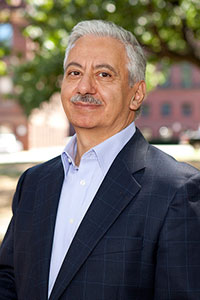News
The Green Energy Materials Summer Research Program brought together 15 students from Harvard, Ulsan National Institute of Science and Technology (UNIST) in Korea, and Jiao Tong University in China, for a thorough study of solar energy. (Photo by Adam Zewe/SEAS Communications.)
While solar cells generate just 1 percent of the world’s electricity today, the International Energy Agency estimates that photovoltaic use will grow by 33 percent annually and, by 2050, solar energy could meet 16 percent of global electricity demand.
An international summer program at the Harvard John A. Paulson School of Engineering and Applied Sciences (SEAS) shed light on two major challenges that could impede that goal—implementing renewable energy solutions on the world stage and improving solar cell efficiency.
The Green Energy Materials Summer Research Program brought together 15 undergraduates -- five each from Harvard, Ulsan National Institute of Science and Technology (UNIST) in Korea, and Jiao Tong University in China -- for a thorough study of solar energy, including a hands-on component in which student teams designed, fabricated, and tested photovoltaic cells.
Faculty from SEAS and both Asian institutions led discussions on light and photon physics, the history of solar cells, and the chemical reactions that enable devices to function efficiently. Student teams then worked together at the Center for Nanoscale Systems (CNS), using intricate nanofabrication techniques to engineer photovoltaic cells.
“It was fascinating to learn how tiny particles and microscopic bits can make a huge difference in the efficiency of solar cells,” said Sophie Pesek, A.B. ’20, an intended environmental science and engineering concentrator. “When coating solar cells, for instance, a completely clean surface is required before bonding. So that means suiting up before you go into the labs and being careful not to drop or touch any of the cells you are working on.”
Working at CNS was a lesson in patience for Pesek, who enjoyed the opportunity to see what research in a lab is really like.

At Harvard's Center for Nanoscale Systems (CNS), students in the Green Energy Materials Summer Research Program used intrifcate nanofabrication techniques to engineer photovoltaic cells. (Photo by Daniel Chang.)
For intended environmental science and engineering concentrator Daniel Chang, A.B. ’20, the two-week program opened his eyes to the array of resources at Harvard. Chang walks by the CNS each day, but never knew nanoscale research was happening under his feet. He was fascinated by the delicate techniques involved in designing silicon sheets that were a fraction of the width of a human hair.
“I had never really considered why solar energy has been such a challenge to implement around the world,” Chang said. “I always thought that the biggest problems were cloudy days or that the science wasn’t there yet. But drilling down and learning that the science is as good as it can be with the most practical resources available gave me an appreciation for what engineers have done so far.”
The maximum efficiency of a silicon panel is currently about 20 percent, and solar cells have advanced to the point that they routinely approach that peak, he explained.
Further improving solar cell efficiency is a chief concern of engineers around the world, since intensifying problems resulting from climate change are threatening the way of life in all nations, said Seunghoon Kim, an engineering student at UNIST.
Kim, who plans a career in the semiconductor industry, hopes to apply skills he learned this summer to far-reaching renewable energy research and development projects.
“Working together is important because it is nearly impossible for one person alone to make a difference. Individuals get stuck on one idea and cannot see any other way,” he said. “We need to collaborate to find a better path forward.”

Students divided into three teams to develop photovoltaic cells, then analyzed the efficiency of their final products. (Photo by Michael Raspuzzi.)
Fostering a collaborative mindset and helping students develop a global perspective are among the goals of the program, now in its second year, said Fawwaz Habbal, Executive Dean for Education and Research.
Students learn to tackle complex challenges using a systems thinking approach and see how they are better suited to solve seemingly intractable problems when they embrace cultural differences and work together, he said.
“Diversity is extremely important in engineering,” he said “Engineers must be sensitive to cultural diversity to have a grasp of the global issues they will work to solve in the future. I hope these students depart with a sense that they can make a difference.”

Fostering a collaborative mindset and helping students develop a global perspective are among the goals of the program, now in its second year. (Photo by Michael Raspuzzi.)
Topics: Environment
Cutting-edge science delivered direct to your inbox.
Join the Harvard SEAS mailing list.
Scientist Profiles
Fawwaz Habbal
Senior Lecturer on Applied Physics
Press Contact
Adam Zewe | 617-496-5878 | azewe@seas.harvard.edu




